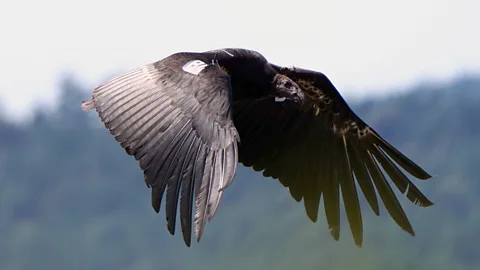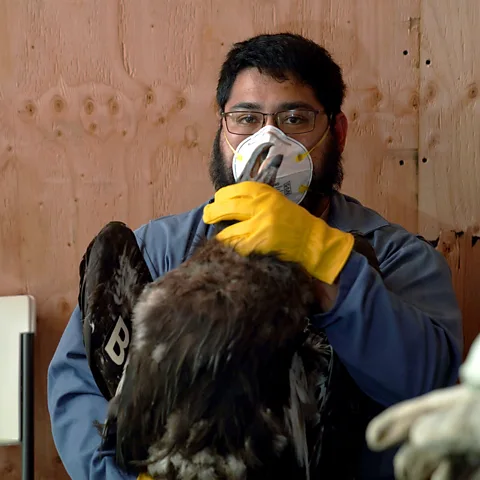How a tribe brought back its sacred California condors
 The Yurok Tribe
The Yurok TribeOn a cloudy day in May 2022, following years of research, it was time for the Yurok Tribe to test whether its captive-bred condors were ready to live in the wild.
Two condors had been chosen, who happened to be "best buds", says Tiana Williams, director of the Yurok Tribe Wildlife Department and member of the Yurok Nation.
The birds were clearly curious about the trap door which opened up in front of them to the wild. They took turns scooching forward on their perch and jumping back, until finally, one bird took the plunge.
"You could see one gearing himself up towards it, and he takes a couple of running steps to the edge, leaps out, and just takes to the sky and soars off," re Williams.
The remaining bird followed seconds later. For the first time in 100 years, sacred condors were flying over Yurok land.
Williams has spent the last 16 years trying to bring back the scavenger birds to her homelands. "Growing up I didn't know anything about condors, and that's the near tragedy."
 The Yurok Tribe
The Yurok TribeThe Yurok Tribe considers the condor a sacred animal, integral to their creation story. But the birds had been absent from Northern California, where the tribe lives, for so long that "they weren't even part of the conversation anymore", says Williams. "We were so close to completely losing this huge part of ourselves."
California condors are the largest land birds in North America, with a wingspan of 9.5ft (2.9m) – that's almost the same length as some compact cars. Condors can weigh up to 25lbs (11.3kg) and travel up to 200 miles (320km) a day searching for food, reaching speeds of 50mph (80km/h).
Historically, the California condor's range stretched from California across the US to Florida, and from Northern Mexico all the way north to Western Canada. But by 1982, just 22 Californian condors remained in the world. The species had been all but wiped out by lead poisoning, illegal killing and the use of the pesticide DDT – which prevents condor eggs from hatching.
The initial hurdle to saving the species was a desire to reduce human involvement, says Chris West, the Yurok Tribe's senior wildlife biologist. "There were serious concerns [that] bringing them into zoos would result in the species going extinct in cages. Many believed it would be better to allow them to die out in the wild, on their own ."
It wasn't even clear why the populations were crashing in the 1980s, adds West. "Or even if they could be bred in captivity," he says.
Extreme lengths
Eventually, though, in 1987, the entire wild condor population was placed into a captive breeding initiative, the California Condor Recovery Program, in a bid to save it from extinction. Scientists realised the birds were being poisoned by lead ammunition used by hunters. As scavengers, they were feeding on animal carcasses that contained fragments of the ammunition.
Once the California breeding programme was underway, scientists found that condors in fact bred well in captivity. The next hurdle was figuring out how to reintroduce a "complex social scavenger" into the wild, says West. "They are so different from many other species that many new ideas and methods had to be developed. We had to learn and innovate as we went," he says.
By the time the Yuroks got involved, California had made strides reintroducing the condor, with the first chick hatching in the wild in 2004. In 2008, there were more California condors flying free in the wild than there were in captivity, a first since the state programme began. As of 2022, there were 347 condors in the wild and 214 in captivity. But efforts were primarily focused on central California, northern Mexico and Arizona – a long way from where the Yuroks live in the misty redwoods on the California-Oregon border.
In the early 2000s, when elders of the tribe gathered to discuss what conservation efforts they should focus on, the first on their list were their fish – the Yuroks are, after all, known as salmon people. But when it came to land animals, the condor was at the forefront of everyone's minds, says Williams.
Condors are called prey-go-neesh in the Yurok language, and feature prominently in tribal ceremonies – they're considered to be messengers who carry prayers into the heavens. But "they hadn't been part of our ecological system [for a long time] – - and they were at risk of disappearing from our spiritual system too", adds Williams.
Trial and error
Determined to bring condors back to the landscape, the tribe created the Yurok Tribal Wildlife Programme in 2008, with condor reintroduction as the main focus. Williams began looking at some of the challenges the project would come up against – including educating the community.
"We had the usual kind of questions when you bring back an endangered species: 'What's it going to mean if they return">window._taboola = window._taboola || []; _taboola.push({ mode: 'alternating-thumbnails-a', container: 'taboola-below-article', placement: 'Below Article', target_type: 'mix' });
